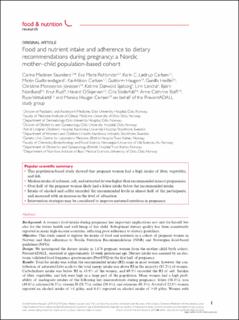| dc.contributor.author | Saunders, Carina Madelen | |
| dc.contributor.author | Rehbinder, Eva Maria | |
| dc.contributor.author | Carlsen, Karin C. Lødrup | |
| dc.contributor.author | Gudbrandsgard, Malèn | |
| dc.contributor.author | Carlsen, Kai-Håkon | |
| dc.contributor.author | Haugen, Guttorm | |
| dc.contributor.author | Hedlin, Gunilla | |
| dc.contributor.author | Jonassen, Christine M | |
| dc.contributor.author | Sjøborg, Katrine Dønvold | |
| dc.contributor.author | Landrø, Linn Aina Ysland | |
| dc.contributor.author | Nordlund, Björn | |
| dc.contributor.author | Rudi, Knut | |
| dc.contributor.author | Skjerven, Håvard Ove | |
| dc.contributor.author | Söderhäll, Cilla | |
| dc.contributor.author | Staff, Anne Cathrine | |
| dc.contributor.author | Vettukattil, Muhammad Riyas | |
| dc.contributor.author | Carlsen, Monica Hauger | |
| dc.date.accessioned | 2020-11-06T10:56:38Z | |
| dc.date.available | 2020-11-06T10:56:38Z | |
| dc.date.created | 2020-01-07T20:19:42Z | |
| dc.date.issued | 2019 | |
| dc.identifier.citation | Food & Nutrition Research. 2019, 63 (2019) 1-11. | en_US |
| dc.identifier.issn | 1654-6628 | |
| dc.identifier.uri | https://hdl.handle.net/11250/2686716 | |
| dc.description.abstract | Background: A woman’s food intake during pregnancy has important implications not only for herself but also for the future health and well-being of her child. Suboptimal dietary quality has been consistently reported in many high-income countries, reflecting poor adherence to dietary guidelines. Objective: This study aimed to explore the intake of food and nutrients in a cohort of pregnant women in Norway and their adherence to Nordic Nutrition Recommendations (NNR) and Norwegian food-based guidelines (NFG). Design: We investigated the dietary intake in 1,674 pregnant women from the mother–child birth cohort, PreventADALL, recruited at approximately 18-week gestational age. Dietary intake was assessed by an electronic validated food frequency questionnaire (PrevFFQ) in the first half of pregnancy. Results: Total fat intake was within the recommended intake (RI) range in most women; however, the contribution of saturated fatty acids to the total energy intake was above RI in the majority (85.2%) of women. Carbohydrate intake was below RI in 43.9% of the women, and 69.5% exceeded the RI of salt. Intakes of fiber, vegetables, and fish were high in a large part of the population. Many women had a high probability of inadequate intakes of the following key micronutrients during pregnancy: folate (54.4%), iron (49.6%), calcium (36.2%), vitamin D (28.7%), iodine (24.4%), and selenium (41.3%). A total of 22.8% women reported an alcohol intake of >1 g/day, and 4.4% reported an alcohol intake of >10 g/day. Women with higher educational levels showed a tendency towards healthier eating habits, except for higher intakes of alcohol and coffee, compared to women with lower educational level. Discussion: Excessive saturated fat intake and limited intake of many important micronutrients during pregnancy were common, potentially increasing the risk for adverse pregnancy and birth outcomes.
Conclusions: This study highlights the need for improved nutritional guidance to pregnant women across all educational levels. | en_US |
| dc.language.iso | eng | en_US |
| dc.rights | Navngivelse 4.0 Internasjonal | * |
| dc.rights.uri | http://creativecommons.org/licenses/by/4.0/deed.no | * |
| dc.title | Food and nutrient intake and adherence to dietary recommendations during pregnancy: a Nordic mother–child population-based cohort. | en_US |
| dc.type | Peer reviewed | en_US |
| dc.type | Journal article | en_US |
| dc.description.version | publishedVersion | en_US |
| dc.source.pagenumber | 1-11 | en_US |
| dc.source.volume | 63 (2019) | en_US |
| dc.source.journal | Food & Nutrition Research | en_US |
| dc.identifier.doi | 10.29219/fnr.v63.3676 | |
| dc.identifier.cristin | 1768052 | |
| cristin.unitcode | 192,12,0,0 | |
| cristin.unitname | Kjemi, bioteknologi og matvitenskap | |
| cristin.ispublished | true | |
| cristin.fulltext | original | |
| cristin.qualitycode | 1 | |

